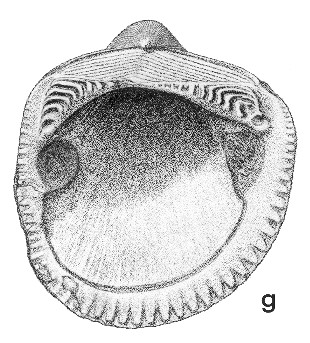
Revised descriptions of New Zealand Cenozoic Mollusca from Beu and Maxwell (1990)

 | Revised descriptions of New Zealand Cenozoic Mollusca from Beu and Maxwell (1990) | 
|
  (Pl. 28g): GS4751, L27/f7520, Oparara River, Karamea district, southwest Nelson, Lillburnian (GNS) |
  (Pl. 28h): GS4751, L27/f7520, Oparara River, Karamea district, southwest Nelson, Lillburnian (GNS) |
Beu & Maxwell (1990): Chapter 13; p. 254; pl. 28 g,h.
Synonymy: Glycymeris rangatira King 1934, p. 27
Classification: Glycymerididae: Glycymeridinae
Description: Largest New Zealand glycymeridid, an enormous, thick, Cucullaea-like shell 85-114 mm high and 80- 105 mm long, very strongly inflated (inflation of 2 valves to 90 mm), with relatively small umbo slightly behind centre of length, lightly convex dorsal margin, long, straight posterior margin, and strongly trigonal shape produced by extended antero-dorsal and postero-ventral margins. Very low, indistinct ridge from umbo to mid-posterior margin (opposite posterior adductor scar) marks off small postero-dorsal area. Whole exterior sculptured with 55-58 very shallow, widely spaced radial grooves, many fine radial threads, and many fine, irregular growth ridges. Ligamental area deep, bearing up to 10 wide, prominent chevron grooves. Hinge wide at ends but obliterated by growth of ligament medially, bearing many similar, long, curved teeth on each end. Adductor scars relatively small, roughened, elevated, dark brown in most specimens (calcific?); pallial line without sinus. Ventral margin coarsely crenulate.
Comparison: This spectacular shell is much the largest of its family in New Zealand (although much larger species of Glycymerita occur in Oligocene-Miocene rocks in Argentina), and is easily recognised by its weakly trigonal shape, by being higher than long, by its very wide ligamental area, and by its weak sculpture. Glycymerita rangatira seems likely to have descended from G. robusta (Altonian and Clifdenian), from which it differs in its larger size, greater height, and weaker umbonal-posterior ridge.
Distribution: Clifdenian-Opoitian; Colonel Gully, Medway River, Awatere Valley, Tongaporutuan (type); widespread in Gisborne district, Hawke's Bay, Wairarapa, Marlborough, and the Karamea district, northern west coast of the South Island, in shallow-water shellbeds with other diverse Mollusca, but nowhere common.
Cite this publication as: "A.G. Beu and J.I. Raine (2009). Revised
descriptions of New Zealand Cenozoic Mollusca from Beu and Maxwell (1990). GNS
Science miscellaneous series no. 27."
© GNS Science, 2009
ISBN
978-0-478-19705-1
ISSN 1177-2441
(Included with a PDF facsimile file
copy of New Zealand Geological Survey Paleontological Bulletin 58 in CD version
from: Publications Officer, GNS Science, P.O. Box 30368 Lower Hutt, New
Zealand)